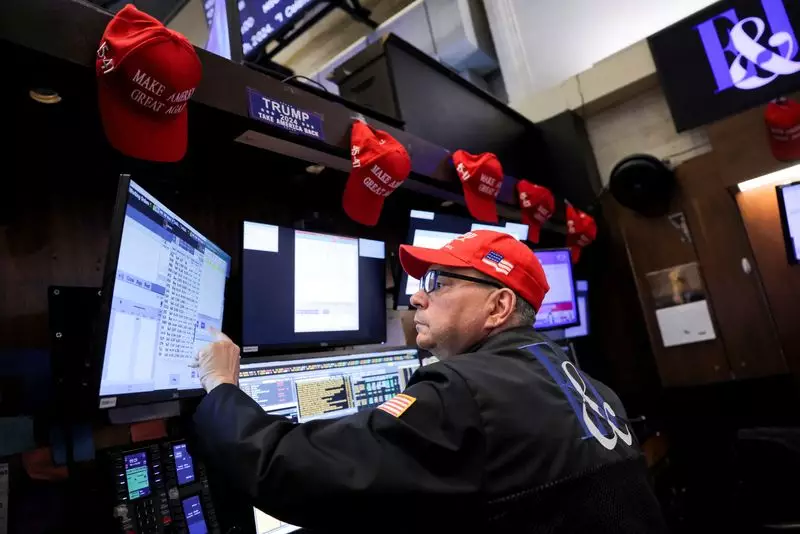The recent announcement by U.S. President-elect Donald Trump indicating an impending 25% tariff on all products from Mexico and Canada, coupled with an additional 10% tariff targeting Chinese goods, has sent ripples through global financial markets. The immediate aftermath, characterized by a significant appreciation of the U.S. dollar against the Canadian and Mexican currencies, highlights the potential volatility that could emerge from such fiscal decisions. As the development unfolds, understanding the implications of these tariffs is crucial for market participants and economies around the globe.
Financial markets are often seen as barometers of economic sentiment, and Trump’s tariff declarations were no exception. Notably, the Canadian dollar and Mexican peso experienced declines, reflecting investor concerns about retaliatory measures and the potential for trade wars. Equity markets in Asia and European futures also tumbled as investors grappled with the uncertainties surrounding the new administration’s trade policies. The S&P 500 futures, which dropped by 0.3%, further underscored the apprehension swirling in the markets.
Market responses are not surprising, given the hefty implications associated with tariffs. Economists and market strategists reacted swiftly, expressing a mixture of shock and skepticism. Gary Ng from Natixis remarked on the strain this could place on Chinese corporate profits, suggesting that while the tariffs on Canada and Mexico are significant, their impact on China may be less profound in relative terms. This observation reveals a critical assessment of how investors perceive the strategic importance of trade relationships and the potential ramifications on financial stability.
Understanding Tariff Strategy: A Game of Negotiation
In a broader context, Trump’s approach to imposing tariffs seems to be a negotiation tactic rather than a definitive policy measure. Simon Yu of Panyao Asset Management likened the tariffs to a bargaining chip, drawing parallels to previous encounters between China and the Trump administration. This suggests that policymakers and investors should brace for a potentially tumultuous negotiation landscape where tariffs are used strategically to leverage improved trade agreements.
The nature of these tariffs raises questions about their implementation timeline and effectiveness. William Reinsch from the Center for Strategic and International Studies characterized the announcement as more of a threat than a policy enactment. Such rhetoric can indeed produce fear-based reactions in markets but may also lead to drawbacks if expectations do not align with practical outcomes. Ultimately, the question remains whether such a confrontational method will yield the desired trade relations or create further friction among trading nations.
The discussions surrounding Trump’s tariff policies elicit a range of long-term implications for U.S. and global economies. George Boubouras from K2 Asset Management emphasized the emergence of a steeper yield curve and potential strength in the U.S. dollar, suggesting that markets might continue to grapple with the anticipated economic shifts. These changes will likely affect consumer prices and the broader supply chain as companies adjust to increased costs of goods imported from affected nations.
Yet, while some analysts view the immediate effects of the tariffs as substantial, others argue that the broader impact may be more muted or delayed. Jason Wong from BNZ pointed out that the market’s fluctuating emotions surrounding Trump’s presidency may have entered a phase reminiscent of 2016 where volatility becomes the expected norm. This reflects a critical reality for investors who must navigate a landscape where tariffs and tweets can influence decisions at a moment’s notice.
As Trump’s administration prepares to take office, the trajectory of U.S. trade policy remains uncertain. Analysts recognize that while immediate reactions are significant, the lasting consequences of tariff implementations require careful analysis. The dialogue surrounding tariffs reflects a fundamental tension between protectionism and globalization, one that policymakers must manage to ensure both domestic and international economic stability.
Strategically, Trump’s positioning indicates that he intends to be assertive in trade negotiations, but the question looms: will this approach create the intended results, or will it trigger retaliation that leads to deeper economic challenges? The unfolding situation merits close attention as markets adjust to new realities and seek clarity in an uncertain environment. Ultimately, the balance between assertive trade policies and constructive negotiation will define the future of international relations for the immediate future.


Leave a Reply